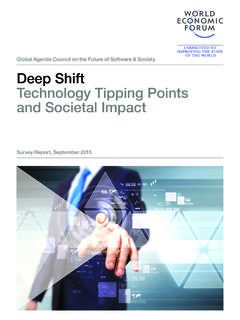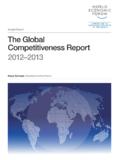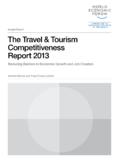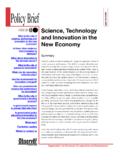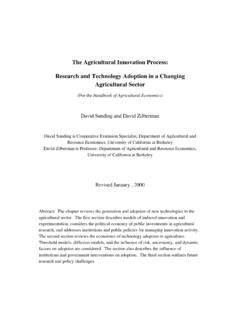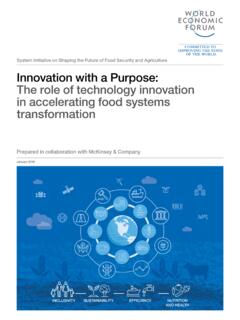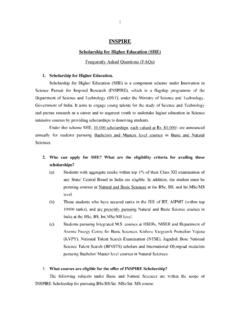Transcription of White Paper China’s Innovation Ecosystem
1 White PaperChina s Innovation EcosystemAugust 2016 World Economic Forum91-93 route de la CapiteCH-1223 Cologny/GenevaSwitzerlandTel.: +41 (0)22 869 1212 Fax: +41 (0)22 786 2744 Email: World Economic Forum 2016 All rights reserved. No part of this publication may be reproduced orTransmitted in any form or by any means, includingPhotocopying and recording, or by any informationStorage and retrieval system. REF 190816 The views expressed in this White Paper are those of the author(s) and do not necessarily represent the views of the World Economic Forum or its Members and Partners.
2 White Papers are submitted to the World Economic Forum as contributions to its insight areas and interactions, and the Forum makes the final decision on the publication of the White Paper . White Papers describe research in progress by the author(s) and are published to elicit comments and further Preface4 Executive summary5 Evaluating Innovation in China 5 The state of Innovation in China strengths 6 The state of Innovation in China - challenges 7 Entrepreneurial ecosystems in China and worldwide10 China s Innovation Policy and Regulations 10 Encouraging Innovation in China 11 Recommendations for improvement in four key areas 11 Innovation and intellectual property 12 Conclusion14 Best practice case studies 14 Innovating at city
3 Level in Shenzhen 15 Manufacturing Innovation 16 Intelligent transportation 17 Science and technology parks and high-tech companies 18 Organizational change and talent management at Haier 19 Continuous Innovation the Huawei Way20 Endnotes22 Contributors 3 White PaperThis end-of-term Paper by the Global Agenda Council on China (2014-2016) considers Innovation in China. It compares China s entrepreneurial and Innovation Ecosystem with others in the rest of the world. At the same time, it suggests ways to improve Innovation in China with reference to engaging case studies that illustrate specific best practices.
4 Above all, it is a call for knowledge development and further 2015, China launched a pioneering programme called Mass Entrepreneurship and Innovation . This is in line with the country s goal to shift from labour-intensive manufacturing to growth driven by Innovation . The country also has an enormous and valuable internal consumer base which is hungry for new to the Chinese National Bureau of Statistics, the country was the number two investor in R&D in the world in 2015. Substantial resources, policy support and energy are being dedicated to upgrading value chains, improving technology and boosting Innovation .
5 The number of innovative projects and patents awarded has increased and more science parks and zones are being established. Online technology particularly ecommerce, internet banking and social media is also accelerating the rapid pace of change. technology has enabled Chinese entrepreneurs to disrupt traditional industries in powerful ways. Start-ups are using crowdfunding, open-source design and Innovation incubators to enable even more radical country s Innovation drive has led to the number of private-sector companies rising fourfold1 in the past ten years.
6 These firms are increasingly moving from imitation to Innovation . They are also expanding out of the domestic market into the global marketplace. Today, companies like Tencent, Baidu and Alibaba are among the top 10 internet companies in the world. It is clear the country has the drive and vision to become an Innovation -driven economy. On behalf of the World Economic Forum, I would like to express my deep gratitude to the Co-Chairs and Members of the Global Agenda Council on China who contributed to this White Paper .
7 The full list of council members is listed in contributors and we are honoured to have worked with such a stellar group of outstanding individuals. I would also like to personally thank our council Co-Chairs, Zhang Xiaoqiang, Vice Chairman, China Center for International Economic Exchanges, and Kevin Rudd, President, Asia Society Policy Institute, for their leadership in steering this council over the past two years to a successful AikmanChief Representative Officer, Greater China Member of the Executive Committee, World Economic Forum Beijing4 Innovation in ChinaExecutive SummaryToday.
8 The world is realizing the remarkable extent of China s capacity to transform its economy by becoming a global leader in science and technology . China has made huge progress in terms of R&D expenditure, the number of high talent projects and awarded patents, and the establishment of scientific demonstration parks and zones. Technological influences ranging from e-commerce and social media to internet finance are helping China leapfrog its Innovation process in all aspects. China still has major challenges to overcome.
9 But it is clear that the country has an enormous drive to become an Innovation -driven economy. Evaluating Innovation in ChinaIn this part of the report we examine China s successes in recent years and look at the challenges that remain. Together with Tsinghua and Stanford Universities, the World Economic Forum Global Agenda Council on China surveyed over 100 entrepreneurs in Greater China. The aim was to understand how entrepreneurial companies become scalable, high-growth businesses by accelerating access to new markets.
10 Responses came mainly from Beijing, Shanghai, Nanjing and Guangzhou. For Chinese entrepreneurs, human capital, accessible markets and regulatory issues are key factors for growth. This is in line with the findings of the Forum s 2014 Entrepreneurial ecosystems around the Globe and Early-Stage Growth Dynamics report. China s Innovation policy and regulationsChina has launched pioneering programmes and is investing heavily to create a healthier Innovation Ecosystem . It is also capitalizing on the potential of its enormous consumer base when it comes to new technology .
